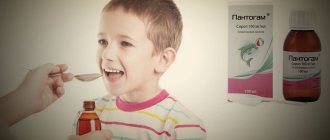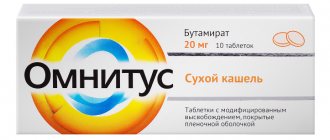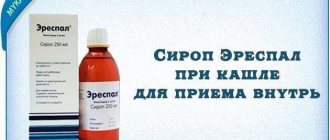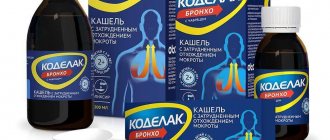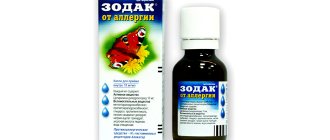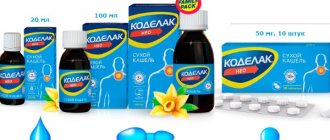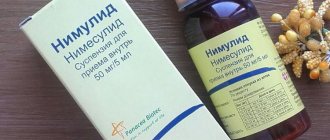pharmachologic effect
Ambroxol belongs to the group of mucolytics. It promotes the production of mucus in the bronchial tree. After ingestion, the drug is transported to the lung tissue, where it stimulates the production of sputum glycoproteins and changes the structure of polysaccharides. As a result, the viscosity of sputum decreases and it comes off more easily.
In addition, the medication stimulates the activity of the cilia of the ciliated epithelium and the motor function of the respiratory tract, which also accelerates the removal of secretions from the bronchial tree.
The drug also increases the formation of surfactant and prevents its breakdown. It is this surfactant that lines the alveoli of the lungs from the inside and prevents them from sticking together during breathing.
Is it possible to use Ambroxol for laryngitis?
Laryngitis is an inflammation of the upper respiratory tract, localized in the trachea - around the vocal cords. Laryngitis is characterized by a barking cough that gives no rest. With severe inflammation, swelling of the laryngeal tissue is possible, leading to blockage of the airways and asphyxia. Therefore, if you have laryngitis, you need to be careful when taking mucolytics. First of all, you need to see a doctor who will give recommendations. It is possible that, along with ambroxol inhalations, vasoconstrictor therapy will be required to provide protection against swelling in the trachea.
Indications
Ambroxol is recommended for children for diseases of the respiratory tract, which are accompanied by a wet cough with the formation of thick, difficult to separate sputum, including diseases such as:
- acute and chronic inflammation of the bronchi;
- irreversible dilatation of the bronchi and disruption of their function caused by a purulent-inflammatory process in the bronchial wall;
- chronic obstructive pulmonary disease;
- inflammation of the lungs (pneumonia).
The drug is prescribed in injections to newborn babies, including premature babies, for the purpose of treating and preventing respiratory distress syndrome or RDS (a severe form of respiratory failure, which is characterized by pulmonary edema, oxygen deprivation of tissues, and impaired external respiration).
Main indications for the use of ambroxol
When the substance enters the patient’s body, it stimulates the motor function of all respiratory organs. The effect that the drug Ambroxol has on humans belongs to the category of expectorant and secretolytic. The product provokes the formation of sputum, the viscosity of which is reduced due to a change in the structure of the secreted fluid. This process explains the mucolytic effect of the drug.
During illness, substances are formed in the body that transport fluids to the lungs, causing such manifestations of the disease as coughing. After taking Ambroxol tablets or syrup, the breakdown of these substances is blocked. The amount of sputum remains unchanged.
The entry of the drug into the body is a signal to trigger metabolic processes occurring in the liver. Absorption is absolutely problem-free; this occurs regardless of how the drug Ambroxol entered the body: in the form of a tablet, syrup or injection. In all cases, the maximum effect is achieved two hours after taking the drug dose.
The half-life of Ambroxol is quite long; the time spent by the body on the process can reach 10–12 hours. And if the patient’s medical history includes a diagnosis such as renal failure, the time increases. This fact does not affect the concentration of the active substance ambroxol hydrochloride.
The drug is excreted by the kidneys. No more than 5% of the substance comes out in its original form. Self-treatment with Ambroxol is not recommended, since the specific gravity of the main active ingredient in tablets and syrup differs. In order not to make a mistake with the dose of the drug, you must take the drug only as prescribed by your doctor.
Pathologies that the drug treats
You can get a specialist appointment to use ambroxol hydrochloride for the following diseases:
Ambroxol is used for asthma
- any forms of obstructive bronchitis;
- bronchiolitis;
- pneumonia, including segmental pneumonia;
- tracheitis;
- laryngitis;
- rhinitis;
- pharyngitis;
- asthma;
- atelectasis;
- in adults – shock lung;
- in newborns - respiratory disorders of various origins.
The recommended dosage of the drug should not be violated. If you discover this fact, you should keep in mind that serious consequences for the body may occur, so it is better to go to the hospital.
At what age can children use Ambroxol?
The age at which children can take Ambroxol should be clarified in the official instructions, since it may differ depending not only on the form of the drug, but also on the manufacturer. For example, syrup produced by Ekolab CJSC is contraindicated for children under 3 years of age, and produced by Tatkhimfarmpreparaty OJSC has no age restrictions.
Drug interactions
The syrup is not prescribed in combination with other mucolytic agents. When treating patients with bronchial asthma, it is allowed to simultaneously prescribe syrup, glucocorticosteroids, and Eufillin. Negative reactions do not develop. Often the medicine is combined with antibacterial medications, which increases the effectiveness of therapy for inflammatory pathologies.
There is no development of complications when combined with cardiac glycosides or diuretics. You cannot simultaneously prescribe syrup with drugs that suppress the cough reflex. Codeine-based products have these properties. In each case, the combination of syrup with other drugs is previously agreed with the doctor.
Instructions for use
During treatment, parents should remember the following:
- Antitussive medications should not be taken simultaneously with a mucolytic agent , since the latter suppress the cough reflex, as a result of which mucus will accumulate in the respiratory tract, which may cause complications.
- When an expectorant is taken simultaneously with antibiotics, it increases the content of antimicrobial agents in bronchial secretions.
- During treatment, breathing exercises are contraindicated.
- In severe cases of the disease, aspiration (removal) of liquefied sputum is necessary.
- It is not advisable to take mucolytic at night.
- In case of bronchial asthma, treatment with an expectorant may intensify the cough.
- At an early stage, Stevens-Johnson or Lyell syndrome can manifest itself as fever, runny nose, cough, sore throat, and body aches. If these symptoms appear, you need to interrupt therapy and go to the hospital.
- Ambroxol should not be mixed with solutions that have an alkaline environment. In addition, it is forbidden to mix the mucolytic with cromoglycic acid.
- The drug may contain benzalkonium chloride, which, if the respiratory tract is hyperactive during inhalation, can provoke bronchospasm.
- If a child is prescribed a hyposodium diet, parents should remember that some dosage forms contain sodium.
- The duration of therapy is selected by the doctor individually depending on the severity of the clinical picture. If 4-5 days have passed since the start of treatment, and signs of the disease persist, then you should consult a doctor.
- If the doctor has prescribed an injection solution for the child, then as soon as the acute period of the illness passes, you need to switch to taking the medication orally.
- The mucolytic effect of the medicine occurs when a large amount of liquid is taken, so during therapy the child should be given a lot of water.
Instructions for use of syrup
The regimen for taking the syrup should be clarified with a doctor or in the official instructions, since it may differ slightly depending on the manufacturer. It should be drunk at the same time as food.
Typically the drug is prescribed in the following doses:
| Age | Single dose in mg | Frequency of intake per day |
| Up to 2 years | 7,5 | twice |
| From 2 to 5 years | 7,5 | three times |
| From 5 to 12 years | 15 | twice—three times |
| From 12 years old | 30 | twice—three times |
Instructions for use of the solution for inhalation and oral administration
The drug should be given orally in solution in the following doses:
| Age | Dose in ml | How many times to drink per day |
| Under 2 years old | 1 | twice |
| 2-6 years | 1 | three times |
| 6-12 years | 2 | twice or thrice |
| From 12 years old | 4 | three times |
You can drink the solution regardless of food. It can be diluted with water, added to tea, juice or milk.
The inhalation schedule is as follows:
| Age | Treatment regimen |
| Up to 6 years | You can do 1 or 2 procedures per day, while the daily dose can vary from 2 to 3 ml. |
| Over 6 years old | You can take 1 or 2 inhalations during the day, and the daily dose should not exceed 2 ml. |
To carry out the procedure, you can use any modern device, with the exception of a steam inhaler. Before inhalation, Ambroxol must be diluted in saline in a 1:1 ratio and only then poured into a nebulizer.
To carry out the procedure, the solution must be at body temperature.
For children suffering from bronchial asthma, inhalation should be done after using bronchodilators, which will prevent bronchospasm.
Instructions for use of tablets
You should take the tablets after meals. They should be swallowed whole with plenty of water.
The treatment regimen must be selected individually depending on the age and severity of the clinical picture:
| Number of complete years | Reception schedule |
| From 6 to 12 | You need to drink Ambroxol 15 mg twice or thrice a day. |
| From 12 | In the first 48-72 hours, take the medicine 30 mg three times a day, then 30 mg twice a day. |
Instructions for use of the injection solution
The medicine must be injected into a vein slowly in a stream or drip, having previously dissolved it in a solution with a pH higher than 6.3, for example, in saline solution, Ringer-Locke solution or glucose.
The dosage for each child is selected depending on body weight. The daily dose is 1.2-1.6 mg per 1 kg of weight, it should be divided into 2 or 3 times.
With RDS it is increased to 10-30 mg per kg of body weight. Such patients need to be administered the daily dose 3 or 4 times.
Pharmacodynamics and pharmacokinetics
After taking the drug orally, its active component is quickly absorbed into the systemic circulation and has a therapeutic effect. The substance slightly increases the amount of sputum in the bronchi or lungs. This leads to the patient coughing up mucus more often, and the organs are cleared of mucus faster, which leads to an acceleration of the healing process.
The product also stimulates the functioning of the lungs and bronchi, especially the epithelium of organs. This leads to faster mucus evacuation. A minimal increase in sputum volume provokes a cough reflex. It manifests itself quite quickly after the initial intake of the drug.
The drug also has other properties:
- Promotes not only the removal of sputum, but also bacteria that multiply when it accumulates excessively in the lower respiratory tract. As a result, the risk of progression of pathologies of inflammatory origin is prevented.
- The drug also makes sputum less viscous, which has a beneficial effect on the condition and stimulates rapid evacuation.
- Stimulates the restoration of the inner layer of the bronchi and lungs.
- The absence of a significant increase in mucus volume helps prevent unwanted reactions that occur with a sharp increase in mucus volume when taking other antitussive medications.
- It does not lead to obstruction of the lungs and bronchi, which helps to avoid severe complications such as coughing attacks or exacerbation of bronchial asthma.
The drug acts quite quickly, the effect is observed within a few days after the start of the therapeutic course. The drug improves the ventilation function of the lungs, which stimulates blood circulation and improves the general condition during the acute course of the disease.
A large concentration of the component in the syrup is found in the tissues of the respiratory tract, which ensures high efficiency. The drug is well absorbed in the body, the maximum concentration in the blood is detected 2 hours after oral administration.
The substance is processed in the liver, where it breaks down into metabolites. Excretion is carried out using the kidneys. In this case, the main amount of metabolites is excreted in the urine, and a small part is evacuated in the feces. In cases of kidney and intestinal disorders, there is a slight deterioration in the process of removing metabolites from the body.
The period of evacuation of components normally takes no more than 24 hours, but in patients with pathologies of the urinary system, an extension of this period is noted.
Contraindications
Ambroxol is contraindicated for children, regardless of its release form, if they are allergic to its composition.
Mucolytic produced by several companies may differ in the composition of additional components.
If the drug contains milk sugar, then it should not be given to patients who have been diagnosed with health problems such as:
- malabsorption of simple carbohydrates such as galactose and glucose;
- lack of lactase (an enzyme that is involved in the breakdown of milk sugar);
- lactose intolerance.
An expectorant should be prescribed with caution in the presence of the following pathologies:
- exacerbation of stomach and duodenal ulcers;
- kidney dysfunction;
- severe liver disease;
- excessive sputum production due to impaired bronchial motor function.
If the medicine contains sorbitol and saccharin, then diabetics should drink it with caution.
If a mucolytic contains ethyl alcohol, then it should be taken with caution if you are prone to drug addiction, alcoholism, or brain pathologies, including epilepsy.
Release form and composition of the drug
The drug can be found on pharmacy shelves in the form of a syrup intended for oral use. It is packaged in special 100 ml dark glass bottles, which are placed in cardboard boxes. The liquid is a thick, sweet mass with a specific medicinal aroma.
When taken, you can feel a specific, fruity taste, which makes it easier to use. The medicine comes with detailed instructions describing all the features of use and possible negative reactions during therapy. The medicine contains the substance ambroxol, which has a therapeutic effect.
Among the auxiliary components are the following:
- Sodium benzoate.
- Glycerol.
- Propylene glycol.
- Sodium saccharinate.
- Sorbitol.
- Citric acid.
- Flavors.
- Menthol.
- Purified water.
Additional substances do not have a therapeutic effect; they are necessary to give consistency and aroma to the product.
Side effects and overdose
Ambroxol in children can cause the following side effects:
- allergies, which manifest as rash, nettle fever, angioedema,
- anaphylaxis, contact dermatitis, itching;
- dyspnea;
- urination disorder;
- runny nose;
- stool retention, indigestion, abdominal pain;
- weakening of the sensitivity of the mouth and pharynx;
- weakness, headaches;
- stomach pain, nausea, vomiting, dry mouth;
- lowering blood pressure;
- fever, chills.
Due to exceeding therapeutic dosages, the child may experience overdose symptoms, such as:
- nausea;
- vomit;
- loose stools;
- abdominal pain;
- short-term anxiety;
- lowering blood pressure.
If signs of intoxication appear, if no more than 2 hours have passed since the poisoning, the child needs to rinse the stomach, induce vomiting, and give fat-containing foods.
Terms, conditions of sale and storage
The drug is an over-the-counter drug available from pharmacies. The maximum duration of its storage is 3 years.
When storing, it is necessary to limit access to children and avoid exposure to sunlight. After the expiration date, use is not allowed.
Analogs
What can replace Ambroxol for children? Analogs of Ambroxol are available for sale:
- Ambrobene;
- Lazolvan;
- Ascoril;
- ACC;
- Bromhexine.
Banana taste and excellent therapeutic effect - children's cough syrup
Ambroxol syrup for children is the latest pharmaceutical development. It helps the child cough up mucus as it reduces its viscosity. Once in the lungs, ambroxol performs another important mission - it “washes away” harmful microbes from the mucous membranes. Thanks to a specially selected composition, the syrup has a positive effect on the metabolism in the lung tissues, which relieves the inflammatory process.
The syrup has a banana (raspberry, strawberry) smell and a pleasant taste, so treatment with it will occur without tears or persuasion.
Mothers should remember this feature when buying ambroxol syrup: the instructions for using the drug are printed directly on the packaging, so you should not throw it away.
Reviews
Moms' opinion
There are both positive and negative reviews about Ambroxol on the Internet. Parents like the following about the medication:
- a wide variety of dosage forms allows you to choose the most suitable one for a particular child;
- the drug is inexpensive;
- The syrup has a pleasant taste that most children like.
Parents leave negative reviews that Ambroxol can cause allergies.
Doctor Komarovsky's opinion
A well-known pediatrician believes that a doctor should prescribe mucolytics for diseases of the lower respiratory tract that are accompanied by a cough in combination with other drugs. He claims that expectorants are less effective than drinking plenty of water.
Despite the fact that mucolytic is included in the list of over-the-counter medications, self-medication is prohibited. Only the doctor should decide how to give Ambroxol to the child.
By
special instructions
When using the product, patients with bronchial asthma must regularly visit a doctor who will conduct auscultation and determine the need for long-term use of the syrup.
During the treatment period, it is worth drinking a sufficient amount of liquid in the form of warm tea, compote or fruit drink. This will help thin the mucus and facilitate its removal from the lungs and bronchi. In the absence of a sufficient amount of fluid, thickening of sputum and stagnation are observed, which can provoke serious complications.
Ambroxol and the “interesting situation” - is there a risk?
Pregnant women should take any medications only with the permission of a doctor. Ambroxol is no exception. The instructions for use warn that the effect of the drug components on fetal development was tested only on animals. The results of such tests were encouraging. However, it is not advisable to treat cough with this remedy before 28 weeks of pregnancy.
The drug penetrates freely into human milk, so nursing mothers can take it in exceptional cases and only after consulting a doctor.
How to avoid side effects: 3 rules and several important notes
To reduce the likelihood of adverse reactions, do not exceed the recommended daily dose, even if you have a severe cough; Contraindications should be taken into account and self-medication should not be done.
Adverse reactions are rare. These include:
- excessive gas formation in the intestines;
- bowel dysfunction;
- indigestion;
- rashes and skin itching;
- slight increase in temperature;
- heartburn.
Babies may experience allergic reactions to the flavorings contained in the syrup. In addition, the child’s parents are not able to accurately determine whether the baby will be able to cope with the increased volume of sputum. Therefore, syrups and drops should only be prescribed to children under 2 years of age by a pediatrician!
There are also comments regarding the interaction of this drug with other medications. Ambroxol should not be given together with medications that suppress the cough reflex. This combination can lead to stagnation of liquefied mucus in the lungs.
Taking ambroxol enhances the effect of antibiotics.
How do patients rate the effectiveness of the drug?
Ambroxol is a medicine familiar from childhood. The fact that this drug has been used by several generations of children and adults speaks of its worthy healing abilities.
The medicine can be bought at a pharmacy without a prescription, as it is proven and safe. Patients often call it the best remedy for those who suffer from cough. They highly appreciate not only the quality, but also the availability of the drug. The cost of ambroxol does not exceed 50 rubles, while its analogues are often sold 3-4 times more expensive!
Moms about the fruity smell and pleasant taste of the medicine. A plus is the cute packaging, as well as the presence of a measuring spoon, with which ambroxol (syrup for children) is sold.
The ambroxol “family” includes several dozen drugs. Among them are “Lazolvan”, “Ambrobene”, “Flavamed”. "Ambrohexal". Having a similar composition and effect, they cannot boast the same affordable price.
If you need a good and inexpensive expectorant, then you should pay attention to ambroxol. It can be used by the whole family. The medicine copes well with its tasks, is not addictive, and with subsequent use it acts as effectively as the first time.
What does ambroxol treat?
Cure cough is the main function of ambroxol. But this drug is prescribed not only to eliminate the symptoms of acute respiratory infections or colds, but also as a component of complex therapy for:
- relapse of chronic bronchitis;
- pneumonia;
- tuberculosis;
- bronchial asthma;
- acute tracheitis.
An exhausting, painful, non-productive cough is not the only problem that Ambroxol relieves. What else does this drug help with? Everyone knows that it thins and removes mucus. But studies have shown that taking this medicine reduces the inflammatory process and strengthens local immunity.
When is it better to choose another drug: contraindications to taking ambroxol
The argument in favor of ambroxol is the limited number of contraindications. This once again proves its safety. The only case when treatment with the drug is strictly prohibited is individual intolerance.
There are also special instructions regarding the administration of different forms. Thus, the drug in tablets is not suitable for children under 6 years of age and for patients who cannot digest lactose. Capsules can only be given from the age of 12, as their dosage is too high for young patients. Ambroxol cannot be combined with codeine-based antitussives.
There are several diseases for which it is better to refrain from taking the mucolytic drug ambroxol, namely:
- peptic ulcer of the stomach and duodenum in the acute stage;
- severe disturbances in the functioning of the liver and kidneys;
- gastritis;
- diabetes.


